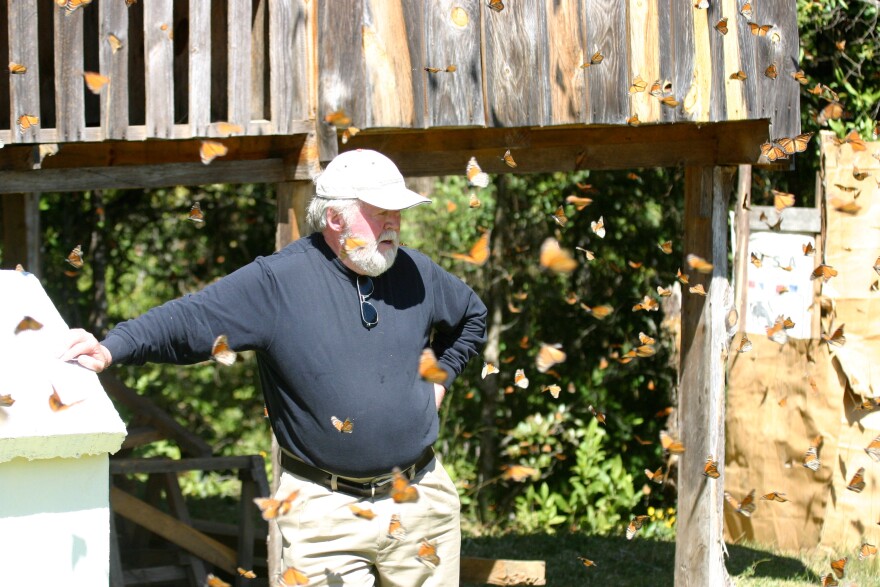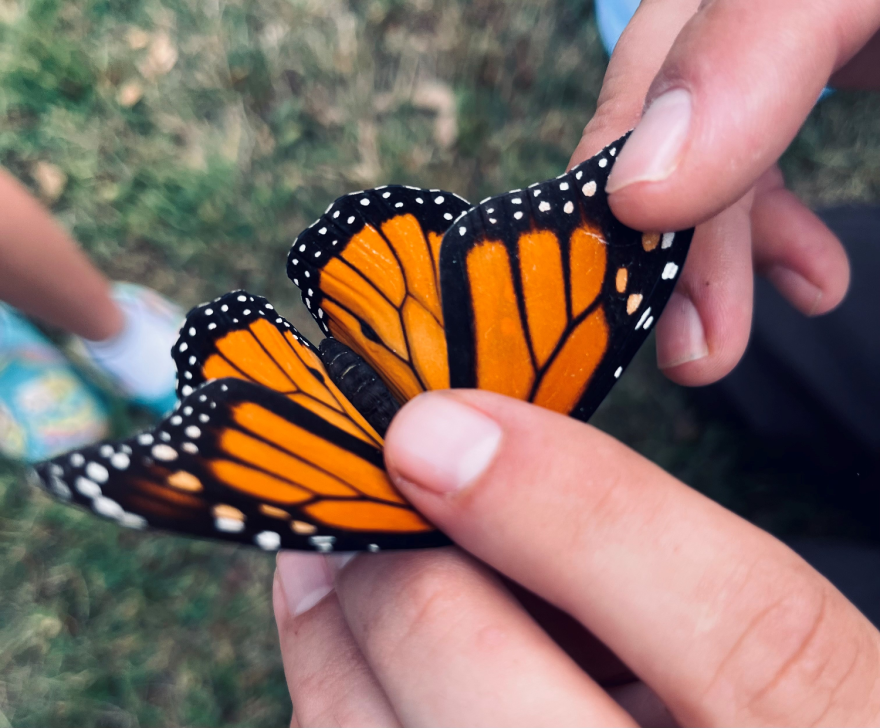With a flutter and flap of wings, monarch butterflies soar through the air. They float from flower to flower at the DeSoto National Wildlife Refuge in Iowa.
Everyone in the Ivey-Caldwell family gives chase — scampering through the wilderness, popping over tall wildflowers on a warm Saturday with nets in hand.
“He’s going to land way up high,” says Laurie Ivey-Caldwell.
She and Julian and their sons, 11-year-old Eli and 10-year-old Ervin, want to be a part of helping monarchs.
“I really love butterflies. I have loved them since I was little, and I love catching them,” says Irvin Ivey-Caldwell.

Monarchs in the Midwest migrate to central Mexico
Park Ranger Peter Rae oversees several late summer outings at DeSoto National Wildlife Refuge where volunteers carefully catch and mark each monarch with a tiny sticker before letting them go.
“There it goes, Adios. Good job,” says Rae.
The goal at the refuge is to tag 300 butterflies this season for researchers to try and follow their path.
“And they’re not flying with another butterfly that has done it before,” Rae said. “It’s an amazing migration.”
The colorful insects travel hundreds or even thousands of miles to reach their destination in time for the Day of the Dead.
Typically, they only live two to six weeks. It’s the fourth or fifth generation of the season known as the “super generation” that makes the migration. Those butterflies live for about nine months before returning to their northern breeding grounds in early spring.

Monarch Watch project works to uncover scientific mysteries
“There is something about a monarch that seems to capture the feelings of people. It’s bright, beautiful and big,” said retired University of Kansas professor Chip Taylor, the founder of Monarch Watch.
Taylor, who previously researched honeybees, started the project out of curiosity about the other winged pollinator’s near-unfathomable migration.
“We knew that the monarchs first reached the overwintering sites in Mexico, almost on the same day, every year, and how is that possible?” he said. “So, we came up with the idea that maybe this is all synchronized with celestial changes.”
And it turns out that it is.
For decades, the non-profit has relied on thousands of volunteers to try and figure out the mysteries behind the long-distance journey east of the Rockies.
“We really don’t have enough arms and legs and places we can be to do all of these things,” he says.
People who find the tagged insects can enter information with Monarch Watch online. Every creature counts since only about 1% are ever recorded, dead or alive, in Mexico.

Through the tagging of more than two million butterflies, spanning more than 30 years, scientists uncovered more details: a majority of the butterflies, 70%, come from the Midwest — and size matters.
“You don't want to be a small pipsqueak here because you don't have the glide power and glide ratio that takes advantage of thermals to get up there and sail and ride with the wind,” Taylor says.
Climate change and other hazards that impact monarchs
Monarch butterfly numbers soared before wide herbicide use and the loss of habitat created a dramatic fall in the 1990s. Taylor says although he’s seen lower in the past decade, climate change could make the monarch migration difficult to maintain.
“Right now, we're seeing March temperatures that are much warmer in Texas. That means that the butterflies go too far north too soon, and that can have a very negative effect on how the population develops each year,” Taylor said. “We're also saying that September is getting warmer and warmer.”
Monarchs do not like to travel when it’s too hot.
“All the political bodies have to get together and say we have a problem,” he says. “But aside from that, and in this country, what we can do is create more habitat.”
Monarch Watch provides free milkweed seeds to help build up habitat, especially in America’s midsection. Milkweed is the only plant monarch caterpillars eat before making the transition from a chrysalis to a full-grown butterfly.
Taylor says drought affects the food supply, especially nectar from flowers the monarchs eat during their long-distance trip. Hot temperatures can also impact breeding and slow the butterflies down, making it difficult for them to reach Mexico in time.

On more than a half dozen occasions, Taylor has visited the forest in central Mexico himself, where colonies of butterflies gather during the winter.
“It can be kind of a spiritual experience,” he said. “Or at least an awe-inspiring experience, if you're a biologist.”
Debate continues on the status of monarchs, with the International Union for Conservation of Nature putting them on the endangered list last year. The U.S. Fish and Wildlife Service has not. But Taylor calls the butterfly a survivor.
“The monarchs show a great deal of resilience, a great deal of adaptability, a great deal of ability to recover from catastrophic mortality,” he said. “So, it's not the vulnerable species that people are making it out to be.”
Volunteers keep the mission of Monarch Watch in flight
The focus now is to tag the butterflies that are still around.
From veterans to those like the Ivey-Caldwell family who are just learning about the flightful creatures, trying to catch a moving target can be difficult.
“These butterflies fly very high and fast. It’s hard to catch them. They are very crafty,” says Laurie Ivey-Caldwell.
The family bagged almost a dozen — if you count the one that got away. The kids even picked up a few pointers.
“I learned how to tell the males and females apart. There are dots on the male's wings, and nothing on the females,” said Ervin Ivey-Caldwell.

His dad says this experience will stick with the kids long into the future.
“When they're sitting there listening to a ranger talk about the impact of what we're doing on a Saturday morning, and then my oldest goes, ‘Let's go be butterfly hunters,’ it's such a direct connection to the experience,” says Julian Ivey-Caldwell.
It’s that type of hands-on participation that thrills Taylor, who, at the age of 86, is planning a metamorphosis of his own. After volunteering all these years, he will step down as director of Monarch Watch at the end of October.
He set up an endowment to fund the salary of his successor and to ensure the support and appreciation for monarchs lives on.
“I'm going to keep active; you know, they're going to have to carry me out,” he said. “I'm still going to write about monarchs, I'm still going to advocate about monarchs.”
Correction: A previous version of this story incorrectly spelled Ervin Ivey-Caldwell's name.
Sheila Brummer is a reporter with Iowa Public Radio.
This story is being distributed in partnership with Harvest Public Media, a collaboration of public media newsrooms in the Midwest. It reports on food systems, agriculture and rural issues.





